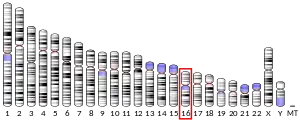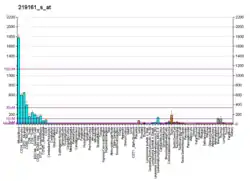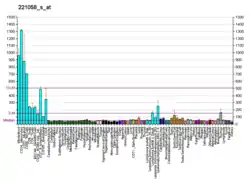| CKLF | |||||||||||||||||||||||||||||||||||||||||||||||||||
|---|---|---|---|---|---|---|---|---|---|---|---|---|---|---|---|---|---|---|---|---|---|---|---|---|---|---|---|---|---|---|---|---|---|---|---|---|---|---|---|---|---|---|---|---|---|---|---|---|---|---|---|
| Identifiers | |||||||||||||||||||||||||||||||||||||||||||||||||||
| Aliases | CKLF, C32, CKLF1, CKLF2, CKLF3, CKLF4, UCK-1, HSPC224, chemokine-like factor, chemokine like factor | ||||||||||||||||||||||||||||||||||||||||||||||||||
| External IDs | OMIM: 616074 MGI: 1922708 HomoloGene: 9663 GeneCards: CKLF | ||||||||||||||||||||||||||||||||||||||||||||||||||
| |||||||||||||||||||||||||||||||||||||||||||||||||||
| |||||||||||||||||||||||||||||||||||||||||||||||||||
| |||||||||||||||||||||||||||||||||||||||||||||||||||
| |||||||||||||||||||||||||||||||||||||||||||||||||||
| |||||||||||||||||||||||||||||||||||||||||||||||||||
| Wikidata | |||||||||||||||||||||||||||||||||||||||||||||||||||
| |||||||||||||||||||||||||||||||||||||||||||||||||||
Chemokine-like factor (CKLF) is a member of the CKLF-like MARVEL transmembrane domain-containing family of proteins that in humans is encoded by the CKLF gene.[5][6] This gene is located on band 22.1 in the long (i.e. "q") arm of chromosome 16.[7]
Isoforms
Through the process of alternative splicing, the CKLF gene encodes 4 CKLF protein isoforms, i.e. proteins made from different areas of the same gene. These isoforms are 1) CKLF1 and CKLF3 proteins that consist of 99 and 67 amino acids, respectively, and are secreted from their parent cells and 2) CKLF2 (which is the full-length product of the CKLF gene) and CKLF4 proteins which consist of 152 and 120 amino acids, respectively, and are located in the membranes of their parent cells.
CKLF1
CKLF1 is the first member of the CKLF-like MARVEL transmembrane domain-containing family of proteins to be defined and the most investigated of its four isoforms.[8] Studies conducted in freshly isolated cells, cultured cells, animals, and tissue samples indicate that CKLF1 is a chemokine-like chemotactic factor that acts through the CCR4 receptors on human CD4+ Th2 lymphocytes, neutrophils, monocytes, macrophages, dendritic cells, and perhaps other CCR4-receptor bearing cells. Preliminary findings suggest that the actions of CKLF1 on these CCR4-bearing cells may contribute to the maturation of various tissues such as blood cells and skeletal muscle from their precursor cells and the regulation of allergic (e.g. asthma), autoimmune (e.g. rheumatoid arthritis and the antiphospholipid syndrome), and inflammatory (e.g. acute respiratory distress syndrome) disorders.[7] Other studies have found that: 1) the benign fibrous skin tumor, keloids, had higher levels of CKLF1 and CKLF1 mRNA than nearby normal skin tissues;[9] 2) CKLF1 levels were higher in ovarian carcinoma tissues than nearby normal ovary tissues and patients with higher levels of CKLF1 in their ovarian cancer tissues had a more aggressive cancer than patients with lover levels of the protein in their ovarian cancer tissues;[9][10] and 3) the levels of CKLF1 protein were higher in cancerous than nearby normal liver tissues in patients with hepatocellular carcinoma (HCC) and patients with higher HCC tissue levels of CKLF1 had poorer overall survival times than patients with lower levels of this protein in their HCC tissues.[11][12] These results suggest that high levels of CKLF1 promote the development and/or progression of these three neoplasms although further studies are required to further define these relationships and to determine if CKLF1 can be used as a marker for their severity and/or a therapeutic target for treating them.[9][10][11]
CKLF2–4
Relative little is known about the normal functions and pathological actions of the CKLF2, CKLF3, and CKLF4 isoforms.[7][9]
References
- 1 2 3 GRCh38: Ensembl release 89: ENSG00000217555 - Ensembl, May 2017
- 1 2 3 GRCm38: Ensembl release 89: ENSMUSG00000054400 - Ensembl, May 2017
- ↑ "Human PubMed Reference:". National Center for Biotechnology Information, U.S. National Library of Medicine.
- ↑ "Mouse PubMed Reference:". National Center for Biotechnology Information, U.S. National Library of Medicine.
- ↑ Zhang QH, Ye M, Wu XY, Ren SX, Zhao M, Zhao CJ, et al. (October 2000). "Cloning and functional analysis of cDNAs with open reading frames for 300 previously undefined genes expressed in CD34+ hematopoietic stem/progenitor cells". Genome Research. 10 (10): 1546–1560. doi:10.1101/gr.140200. PMC 310934. PMID 11042152.
- ↑ Han W, Lou Y, Tang J, Zhang Y, Chen Y, Li Y, et al. (July 2001). "Molecular cloning and characterization of chemokine-like factor 1 (CKLF1), a novel human cytokine with unique structure and potential chemotactic activity". The Biochemical Journal. 357 (Pt 1): 127–135. doi:10.1042/0264-6021:3570127. PMC 1221935. PMID 11415443.
- 1 2 3 Duan HJ, Li XY, Liu C, Deng XL (April 2020). "Chemokine-like factor-like MARVEL transmembrane domain-containing family in autoimmune diseases". Chinese Medical Journal. 133 (8): 951–958. doi:10.1097/CM9.0000000000000747. PMC 7176445. PMID 32195671.
- ↑ Ge YY, Duan HJ, Deng XL (April 2021). "Possible effects of chemokine-like factor-like MARVEL transmembrane domain-containing family on antiphospholipid syndrome". Chinese Medical Journal. 134 (14): 1661–1668. doi:10.1097/CM9.0000000000001449. PMC 8318642. PMID 33813507.
- 1 2 3 4 Cai X, Deng J, Ming Q, Cai H, Chen Z (October 2020). "Chemokine-like factor 1: A promising therapeutic target in human diseases". Experimental Biology and Medicine. 245 (16): 1518–1528. doi:10.1177/1535370220945225. PMC 7553088. PMID 32715782.
- 1 2 Liu DD, Song XY, Yang PF, Ai QD, Wang YY, Feng XY, et al. (February 2018). "Progress in pharmacological research of chemokine like factor 1 (CKLF1)". Cytokine. 102: 41–50. doi:10.1016/j.cyto.2017.12.002. PMID 29275012. S2CID 43860573.
- 1 2 Liu Y, Liu L, Zhou Y, Zhou P, Yan Q, Chen X, et al. (July 2019). "CKLF1 Enhances Inflammation-Mediated Carcinogenesis and Prevents Doxorubicin-Induced Apoptosis via IL6/STAT3 Signaling in HCC". Clinical Cancer Research. 25 (13): 4141–4154. doi:10.1158/1078-0432.CCR-18-3510. PMID 30918019. S2CID 85544946.
- ↑ Li M, Luo F, Tian X, Yin S, Zhou L, Zheng S (2020). "Chemokine-Like Factor-Like MARVEL Transmembrane Domain-Containing Family in Hepatocellular Carcinoma: Latest Advances". Frontiers in Oncology. 10: 595973. doi:10.3389/fonc.2020.595973. PMC 7691587. PMID 33282744.
Further reading
- Boudinot P, Salhi S, Blanco M, Benmansour A (July 2001). "Viral haemorrhagic septicaemia virus induces vig-2, a new interferon-responsive gene in rainbow trout". Fish & Shellfish Immunology. 11 (5): 383–397. doi:10.1006/fsim.2000.0326. PMID 11478515.
- Xia D, Li X, Lou Y, Han W, Ding P, Zhang Y, et al. (August 2002). "Overexpression of chemokine-like factor 2 promotes the proliferation and survival of C2C12 skeletal muscle cells". Biochimica et Biophysica Acta (BBA) - Molecular Cell Research. 1591 (1–3): 163–173. doi:10.1016/S0167-4889(02)00270-7. PMID 12183067.
- Ke X, Jia L, Jing H, Liu Y, Zhang Y, Di C (June 2002). "Effects of novel human chemokine-like factor 1 (CKLF1) on bone marrow hematopoietic stem cell/progenitor cell in vitro". Zhonghua Xue Ye Xue Za Zhi = Zhonghua Xueyexue Zazhi. 23 (6): 301–303. PMID 12411060.
- Xu M, Han W, Qian M, Ma X, Ding P, Wang Y, et al. (January 2004). "Last intron of the chemokine-like factor gene contains a putative promoter for the downstream CKLF super family member 1 gene". Biochemical and Biophysical Research Communications. 313 (1): 135–141. doi:10.1016/j.bbrc.2003.11.100. PMID 14672709.
External links
- Human CKLF genome location and CKLF gene details page in the UCSC Genome Browser.





